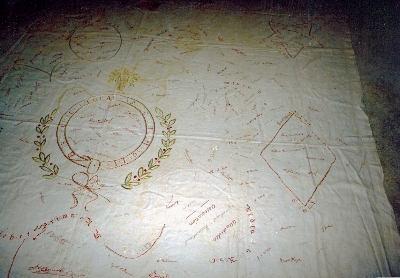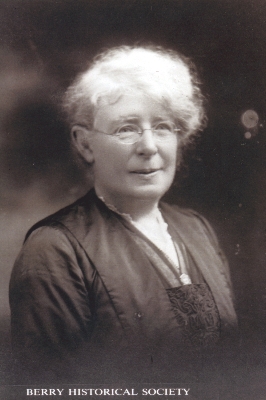Quilt No.20BHS - Berry & District Historical Society

The quilt was made by Miss Ida Lewers, of 'Lyntonstowe', Pulman Street, Berry. The quilt was signed by visitors to the 1906 Berry show, and raffled at the 1907 show. It was won by Master D. McIlvride of Berry. It eventually passed to his son Keith, who married Maria Campbell of Gerringong. It was later given to Arthur and Lorna Campbell, then to the Berry Agricultural Society, who gave it, on permanent loan, to the Berry Museum NSW. "At one stage before reaching us it was thrown out in a 'pile of Auntie's old rubbish', from which it was fortunately rescued." [Elaine Mabbutt, Curator Berry Museum 26.5.95]
"Ida Lewers was unmarried and kept house for her brother Thomas Ross Lewers who was the doctor in Berry until his death, when she left the district. She took an active part in the social life of the town and was one of the founder members of its Red Cross Association. After WWI she worked in the Red Cross shop in Berry which sold handwork made by returned servicemen. Judging by the many delightful postcards she wrote to her little nephews and nieces, which we have, she was an affectionate and fun-loving aunt!
I have no information on the uses to which the quilt was put in the McIlvride family. However when it came to us it was badly stained and I think some of the marks were tea-stains, so it may have been used as a table-cloth. � Also in some places the embroidery threads are damaged or missing, so it might at some time have received some wear."
[Elaine Mabbutt Curator Berry Museum]
The 'Berry Lancers' one group who signed the quilt top were part of the 1st Light Horse Regiment, which, in 1904, had a half squadron, or more probably a troop (approx. 30 men), stationed in Berry.

Related Quilts:
1520 x 990 mm
2040 x 1750mm
Down the centre field of the design and 4 poems embroidered in quite crude chain stitch. Each piece of prose is accompanied by an appliquéd illustration. For example a large clock accompanies a poem of time. 'While shepherds watch their flocks at night�.'is illustrated with a beautiful scene of the manger watched by an angel, cows and sheep. The appliqué and embroidery is executed crudely with large stitches in running and overcasting. The quilt is signed, 'M.J.H. aged 84 yrs.1924.' " [NGA] There is no padding or lining. 1640 x 1540mm
1540 x 950mm






